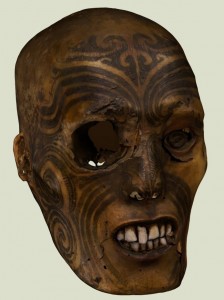 In a solemn ceremony, Maori elders reclaimed the tattooed and preserved head of a Maori warrior from museum and government officials in Rouen, France. Sebastien Minchin, the director of Rouen’s Museum of Natural History, carried the toi moko (the Maori term for the tattoo and the head that bears it) in a case draped with a Maori ceremonial black shawl while Maori elder Kataraina Pitiroi sang a karanga, a ceremonial call-out song, then formally returned it to the delegation of elders, New Zealand Embassy officials and representatives from Te Papa Tongarewa, New Zealand’s national museum. You can see video of the ceremonial hand-over here.
In a solemn ceremony, Maori elders reclaimed the tattooed and preserved head of a Maori warrior from museum and government officials in Rouen, France. Sebastien Minchin, the director of Rouen’s Museum of Natural History, carried the toi moko (the Maori term for the tattoo and the head that bears it) in a case draped with a Maori ceremonial black shawl while Maori elder Kataraina Pitiroi sang a karanga, a ceremonial call-out song, then formally returned it to the delegation of elders, New Zealand Embassy officials and representatives from Te Papa Tongarewa, New Zealand’s national museum. You can see video of the ceremonial hand-over here.
This is the culmination of years of legal wrangling in France. The head, a sacred cultural object to the Maori dating back to the late 18th century or early 19th century, was originally preserved as a reminder of a victory in battle. The tattoos indicate high rank and the heads of elaborately-tattooed warriors would be kept as prized objects by the winners.
After James Cook mapped the coast of New Zealand in 1769 opening the door to further European exploration and mercantilism, a brisk trade in toi moko developed, populating the museums of Europe, and later the US, with these objects of fascination/human remains. Eventually, demand in Europe for the tattooed heads was so high that tribespeople were murdered just for their heads. Slaves captured in warfare would be tattooed right quick, decapitated and their heads sold. Because of its increasing brutality, the trade in tattooed heads was officially outlawed by Britain in 1831.
Rouen’s toi moko had been donated by a Parisian collector named Drouet to the Museum of Natural History in 1875. It went on public display in the museum until it closed in 1996. Then it was kept in storage for a decade until curators doing inventory before the re-opening of the museum found it. This was in 2006, and the city council, headed by the mayor of Rouen, Pierre Albertini, immediately proposed to return the head to New Zealand. The Maori had been asking for their ancestral heads back for two decades by then; it wasn’t even a controversial position, really. Most countries had already returned their head collections or were working on it.
The French Culture Ministry, however, put an immediate stop to the plan. According to the ministry, the museum by law had to consult with a scientific committee before making any offers to return anything. France’s national government has a blanket policy of considering pretty much everything in its museums as part of France’s national heritage, no matter where it came from and under what circumstances, based on the age-old finders keepers philosophy of ethics. The underlying fear was that allowing Rouen to one-sidedly return the toi moko would open a Pandora’s Box of demands for repatriation.
An administrative court backed the government’s position so for years the toi moko remained in storage in Rouen. Recognizing the specific cultural significance of the toi moko, French senator Catherine Morin-Desailly submitted a bill the French senate in early 2008 that would allow the return of the Maori heads in France, not just the Rouen one but 15 others from public collections all over France as well. The bill was passed unanimously by the Senate in June of 2009, and finally by the National Assembly in May 2010.
They made a point, however, of emphasizing that this was a particular exception based on the human dignity of the remains and the strong cultural traditions of the Maori in modern-day New Zealand. “The minister emphasises that this very particular case must be placed within its specific context and should not be confused with the debate about other claims concerning certain items in the public collections.”
Now, a year later, the first toi moko, the one that started it all in Rouen, is on its way back home. It will be placed in a sacred space of the Te Papa museum on May 12th, along with a number of other toi moko retrieved along the way in Sweden, Germany and Norway. The rest of the French toi moko will be returned to New Zealand in 2012.
Well that’s one way to get a leg up!
With experience working in three museums, it is no surprise to hear that this head was eventually “found” and returned after a long delay. If the public were allowed in, there is much to be found and many such curiosities tucked away in the storage vaults of museums large and small.
の人気
A bit off-topic, but have you ever listened to the New Zealand national anthem? Between it and South Africa’s, it is by far, the two greatest national anthems on the planet.
I just wanted to say that, because I just heard it today. Go to youtube and listen to it. It’s wonderful.